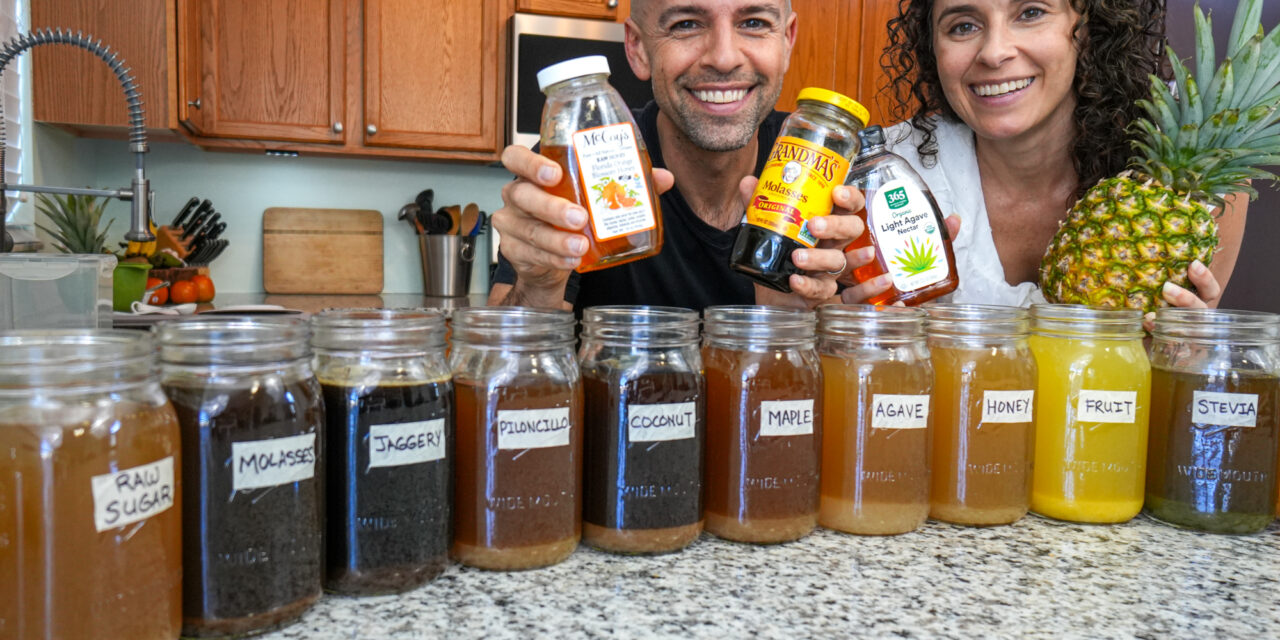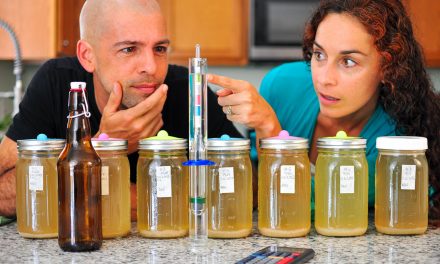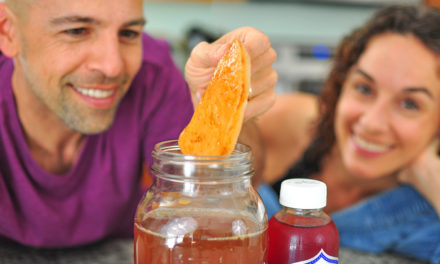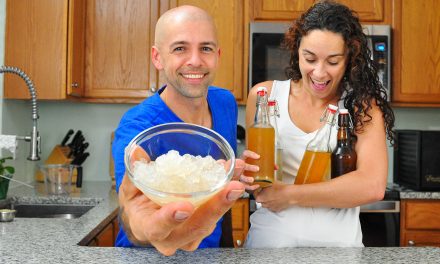If you’ve been around here for a while, you know we’re crazy about making homemade fermented sodas using a ginger bug! We love it so much which is why we like to make large batches to share with our friends and family.
We’ve made countless batches of fermented sodas like our homemade fermented ginger ale, but we typically use raw sugar which has always works well for us. Since there are many different types of sugar around the world, we want to help answer one of your most frequently asked questions:
Which sugars ferment?
To help answer this question, we put ten of the most popular sugars around the world to the test. If you prefer to watch this fun experiment, we also released a video with all the results. Plus, we’ll even try to ferment with no sugar at all. It’s experiment time!
Here’s some of the most popular sugars that we get the most questions about on our channel:
- Raw Cane Sugar
- Molasses
- Jaggery
- Piloncillo
- Coconut Palm Sugar
- Maple Syrup
- Agave Nectar
- Honey
- Fruit
- Stevia
- No Sugar
Click on any of the sugars above to see if fermented in our experiment, or keep scrolling to learn about all the sugars!
Basically we’ve received so many versions of the question, can you make fermented sodas like ginger ale using other types of sugar, that we decided to do an experiment and test them all!
Check out the full video and subscribe to our YouTube channel. We appreciate your support! ❤️
If you’re curious about making homemade ginger ale, these two videos will give you everything you need to make your own batch of ginger ale:
So let’s get started with our experiment!
Types of Sugar – A Fermented Soda Experiment
There are many types of sugar that we can use in the fermentation process. Below are the amounts we think work well for our one quart ginger ale recipe. We used 1/4 cup (60 grams) ginger bug for all of the recipes below.
(Makes 1 quart)
Raw Cane Sugar
Can I use raw cane sugar to make fermented sodas?
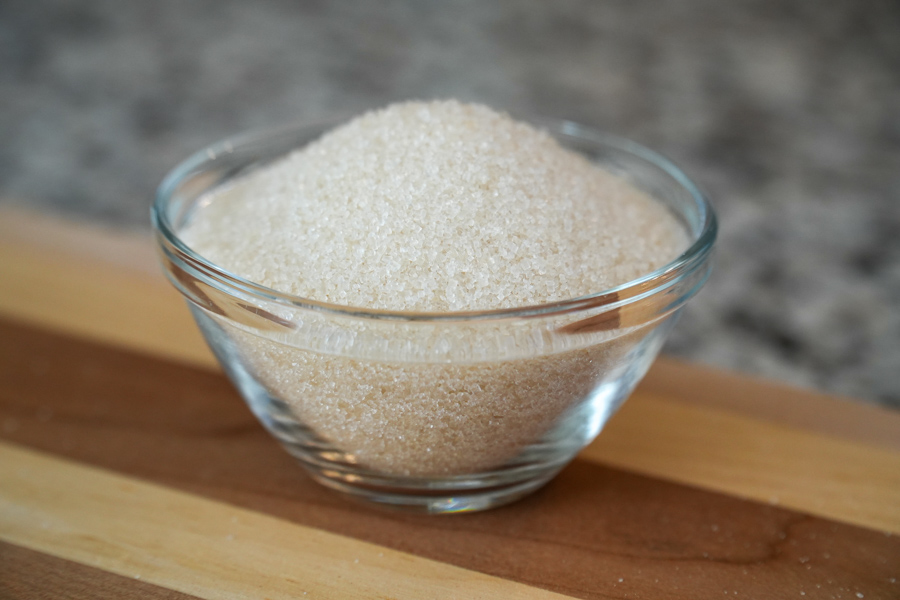
The most popular sugar by far is table sugar from sugarcane. We like using the raw form of this common sugar called raw cane sugar.
Amount: 1/2 cup (110 grams) *** This is our control to judge sweetness in this experiment ***
Verdict: Success! 😊😊😊
We’ve made ginger ale and other fermented sodas many times with raw cane sugar. It works well and tastes clean with a golden color.
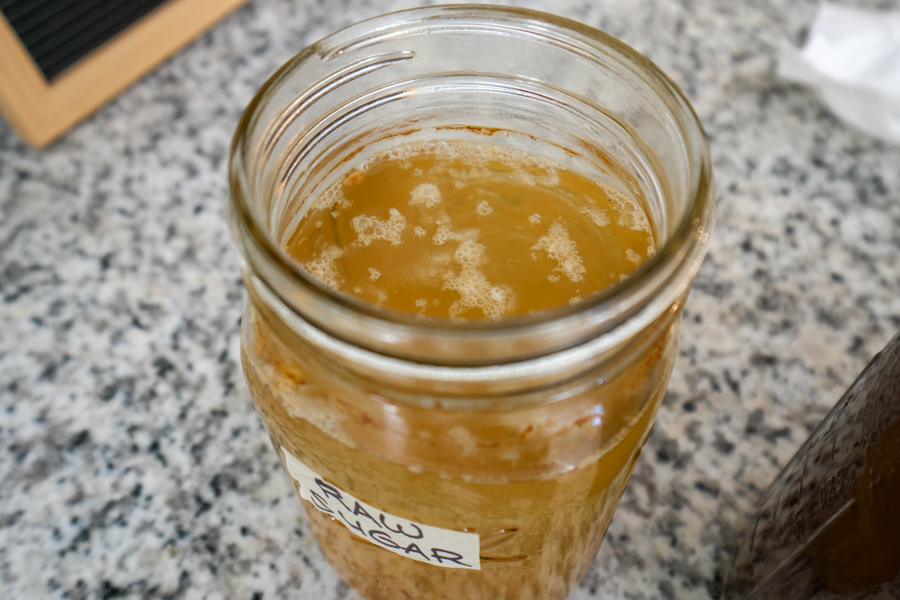
Molasses
Can I use molasses to make fermented sodas?
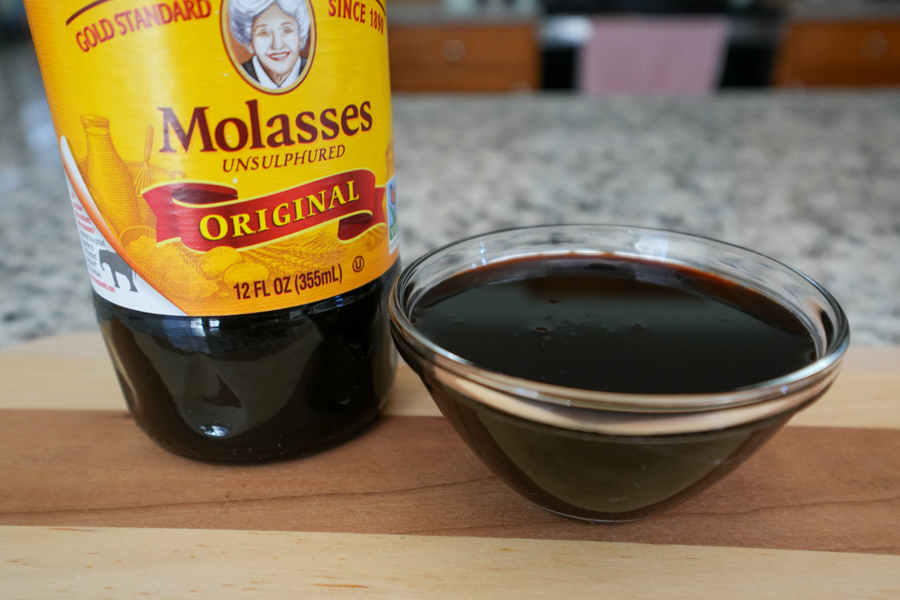
Not only for baking, molasses can be used in your ferments creating a very dark color and distinct flavor. Molasses is what’s removed from sugarcane during the sugar refining process and then added back to refined sugar to make “brown sugar”.
Amount: 1/2 cup (165 grams)
Verdict: Success. 😐
Yes, you can use molasses in your ferments, but it’s not our personal favorite as it became more sour than when we use raw sugar. Although if you love the molasses flavor, you might really love using molasses in your fermented sodas because it really keeps the molasses flavor. Another item to note is that we had to keep scraping off the kahm yeast that kept forming on the top of the molasses ginger ale.

Jaggery
Can I use jaggery to make fermented sodas?
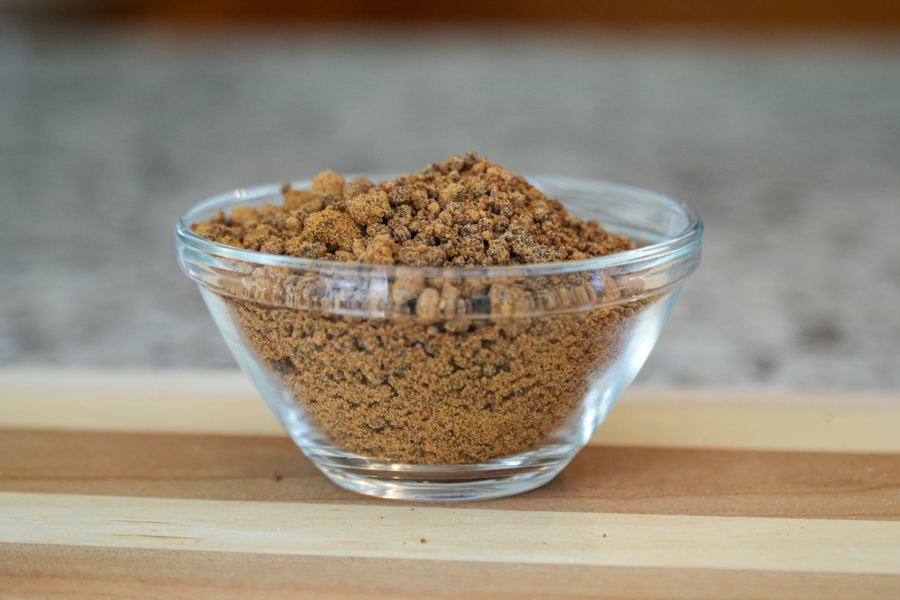
Jaggery (also called gur) is a type of raw sugar that’s popular in India. It mostly comes from sugarcane but can also be from dates or coconut palms. It’s not centrifuged so it retains all of the minerals from the original sugarcane, which gives it its dark color. It’s slightly less sweet than sugarcane, so used a bit more jaggery in our recipe.
Amount: 1/2 cup + 3 tablespoons (110 grams)
Verdict: Success. 😝🍋
Yes, you can use jaggery to ferment, but it creates a VERY sour flavor in a short amount of time! Perhaps we’re just not used to that level of sourness in our fermented ginger ale, but we didn’t fall in love with that flavor just yet.
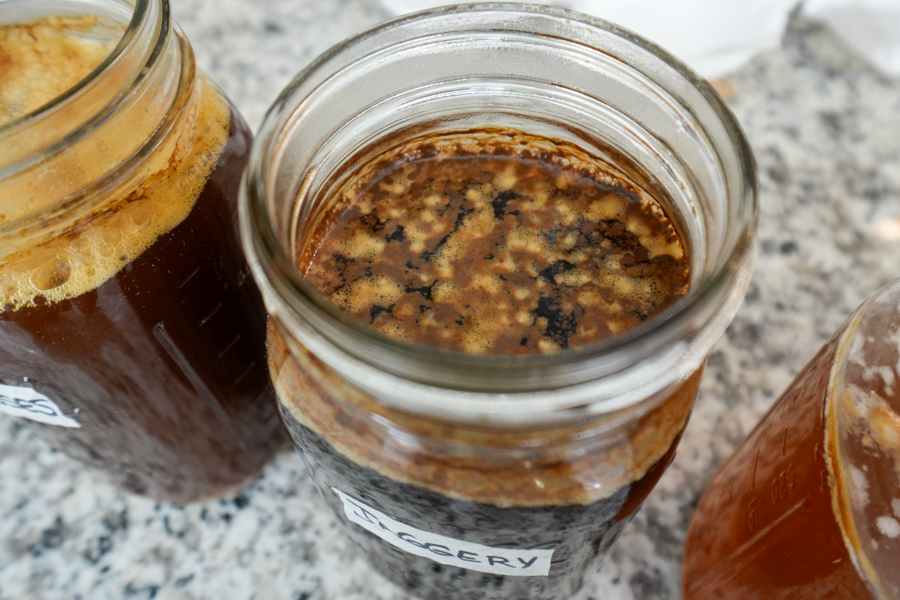
Piloncillo
Can I use piloncillo to make fermented sodas?
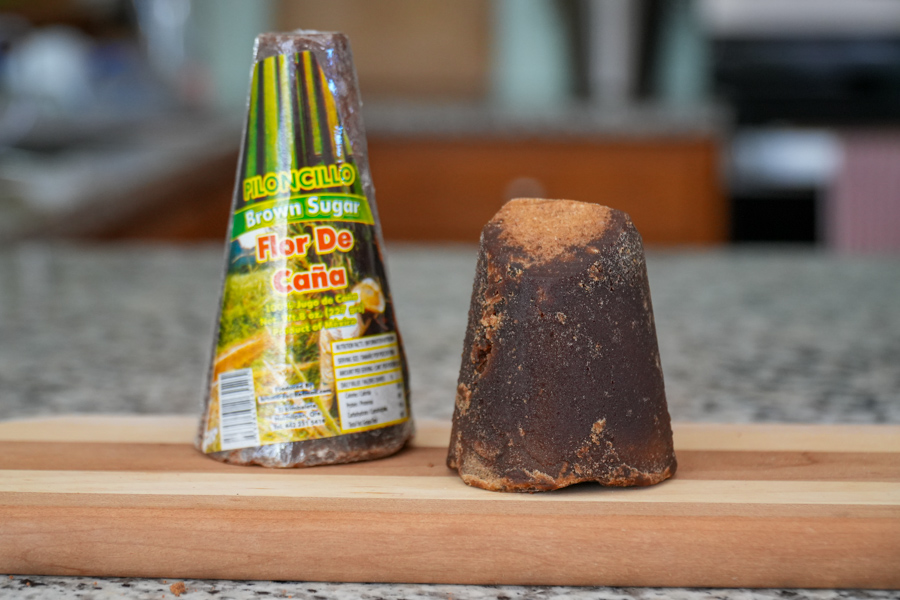
Piloncillo is similar to jaggery in processing, but it’s 100% from sugarcane. Piloncillo is made in Mexico, so it’s a popular sugar in that part of the world. It’s usually slightly lighter in color than jaggery and has a milder flavor. In the grocery store, you’ll find it formed into cone or block shapes that you have to grind, grate, or melt, but it can also come in granulated form.
Amount: 1/2 cup packed (110 grams)
Verdict: Success! 🙂
Yes, you can use piloncillo in your ferments. It does produces a slight sour flavor, but we found it to be pleasant.
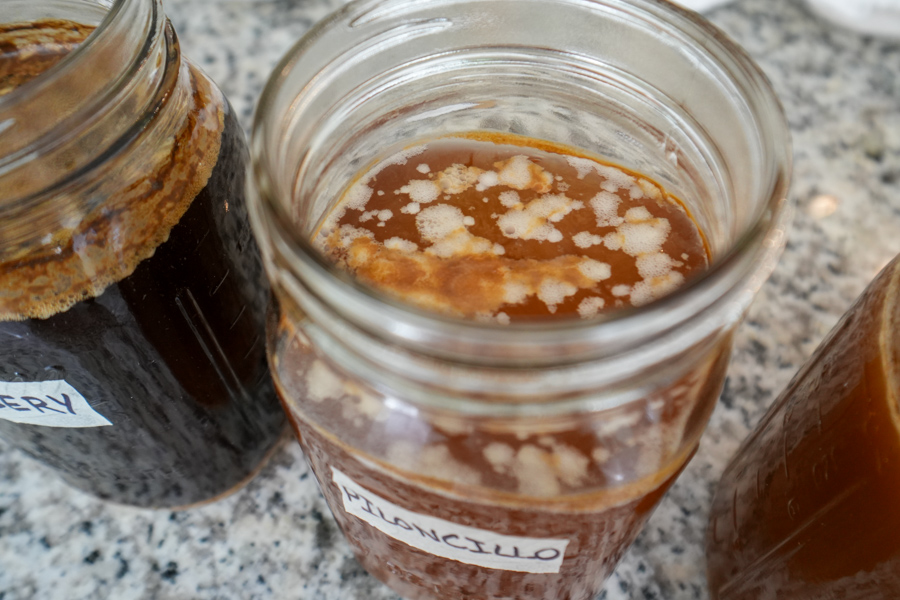
Coconut Palm Sugar
Can I use coconut sugar to make fermented sodas?
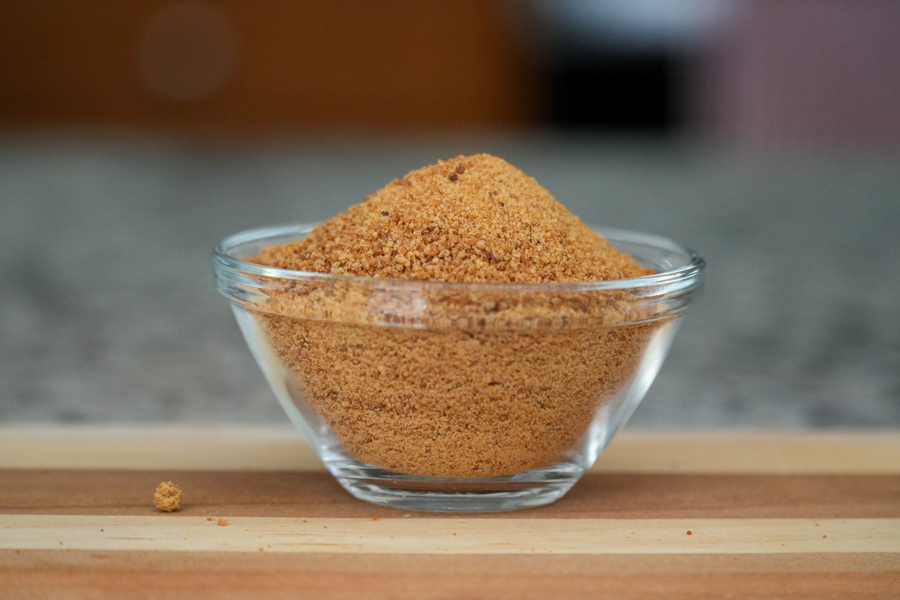
Coconut palm sugar is made by boiling the sap of coconut palms and then refining it. It’s produced in Southeast Asia and is very popular in the Philippines. Coconut sugar has a slight molasses-like and caramel flavor, so it can be great for baking. The sweetness level is fairly similar to that of raw sugar.
Amount: 1/2 cup (110 grams)
Verdict: Success! 🙂
We enjoyed the flavor of our homemade ginger ale fermented with coconut palm sugar. It was slightly sour, but pleasant. Also, we love coconut, so we were surprised to find that the coconut flavor did not shine through after fermentation.
Our first batch of ginger ale using coconut sugar failed to ferment, most likely due to the brand that we used, but we finally found another coconut sugar that fermented very well:
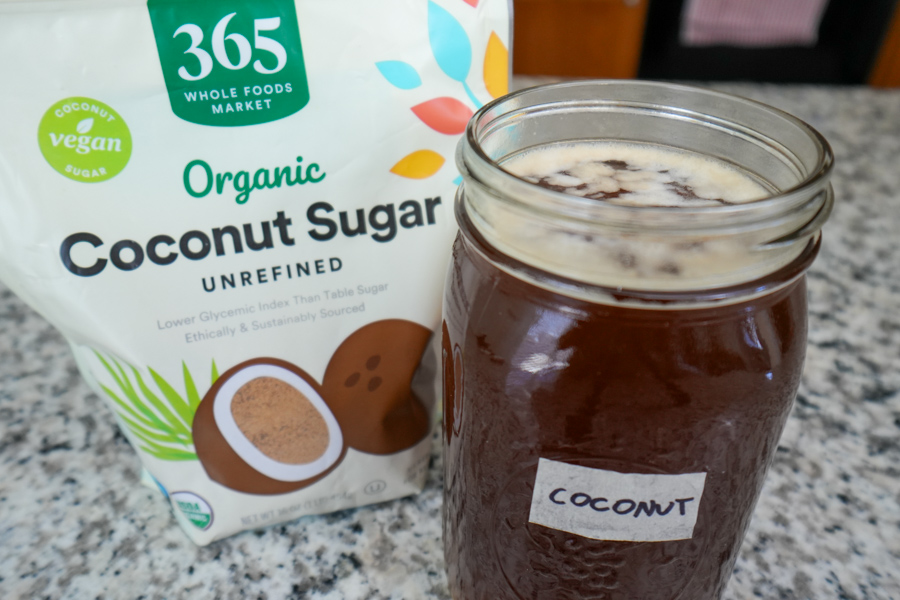
Our first attempt at using a popular coconut palm sugar failed multiple times, getting very thick and sludgy. We even tried boiling the coconut sugar to kill whatever bacteria was making it thick, but it still failed. So, we’ll stick to the brand of coconut sugar above that fermented well.
This is what it looked like: 🤢🤮
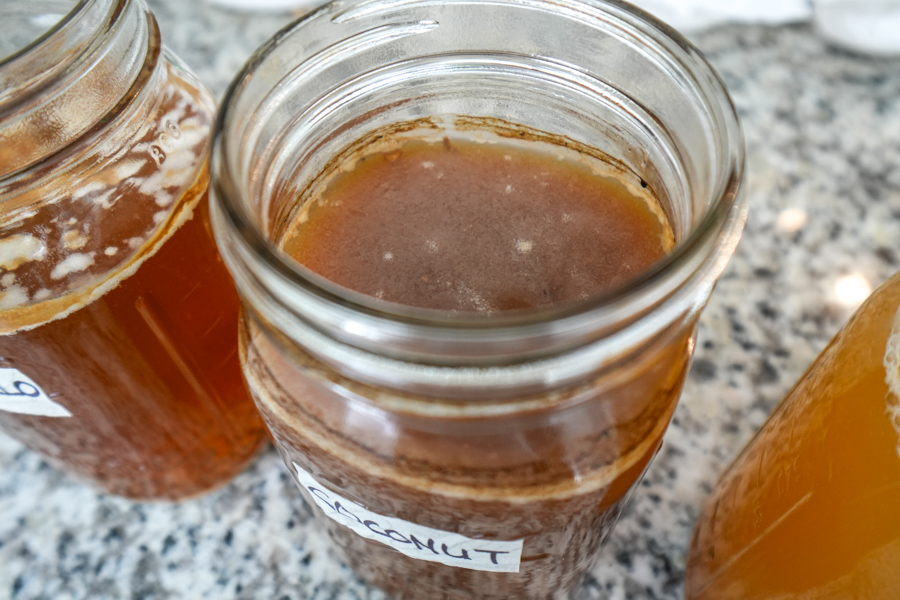
Maple Syrup
Can I use maple syrup to make fermented sodas?
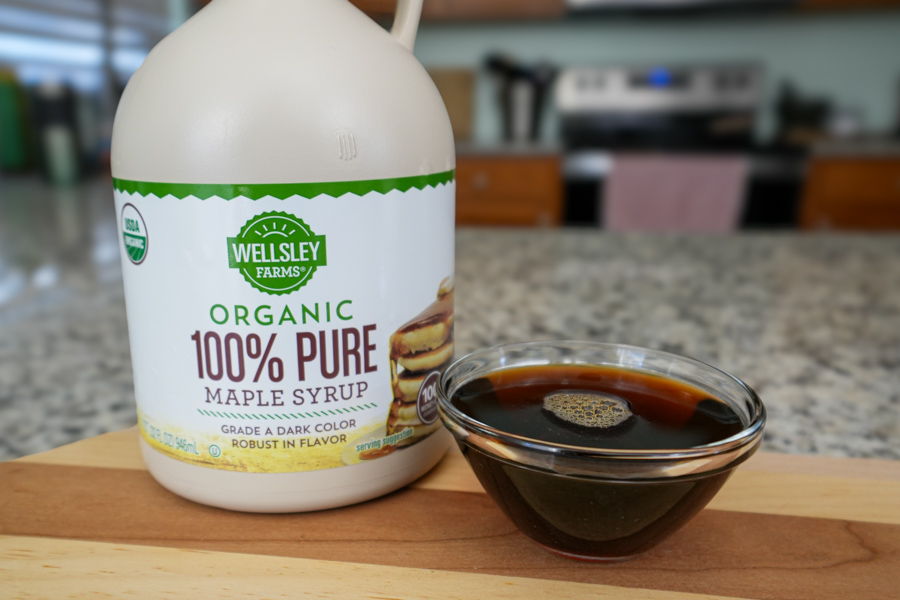
Maple syrup is very popular in Canada, where most of the maple syrup in the world is made. It’s made by tapping maple trees to collect the maple water from the tree. Each tap can usually collect about ten gallons of maple water which is then boiled down to about one quart of maple syrup. So every one gallon of maple syrup takes forty gallons of maple water to make!
Amount: 1/2 cup (110 grams)
Verdict: Success! 🙂🍁
It’s not just for pancakes, maple syrup ferments well! The maple flavor really came through during fermentation, so if you like maple syrup like we do, you’ll love this!
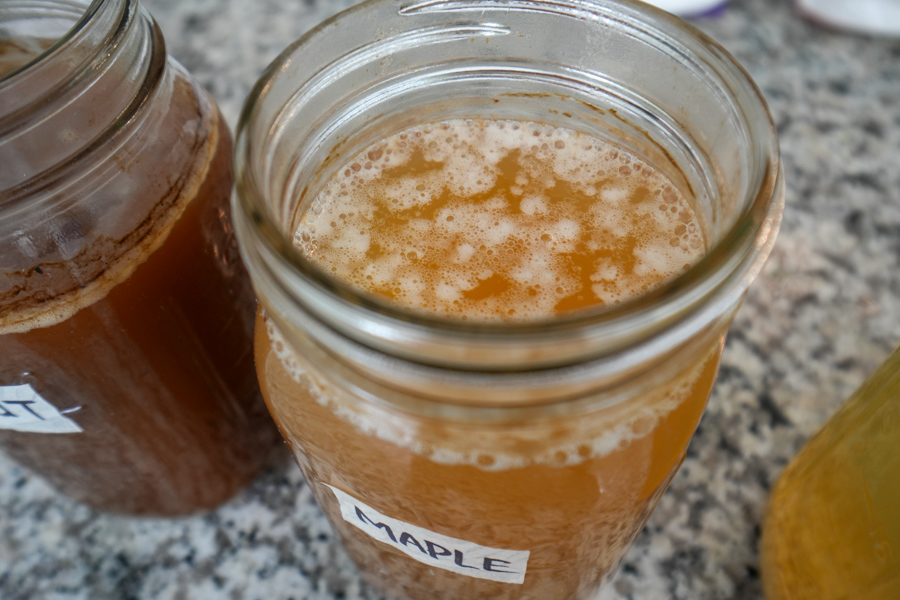
Agave Nectar
Can I use agave nectar to make fermented sodas?
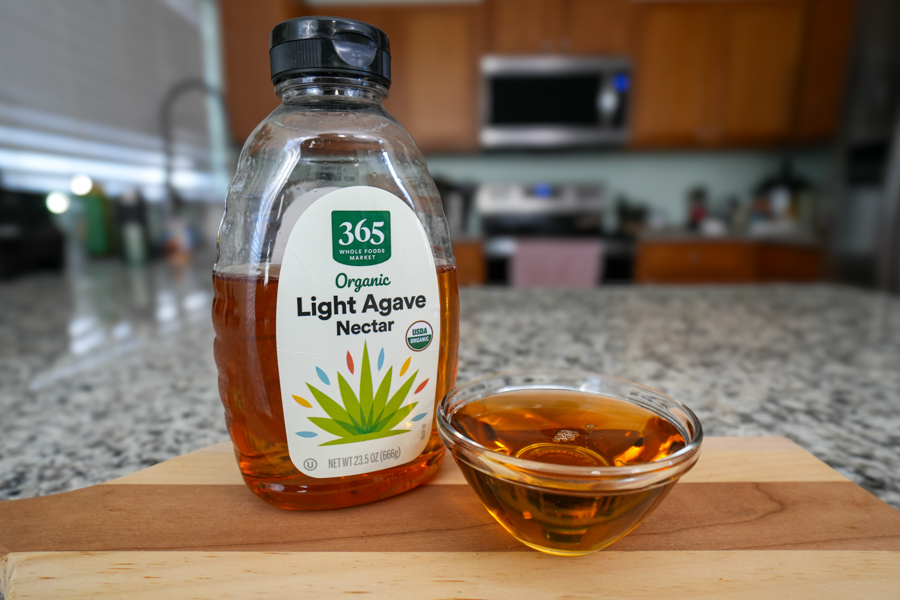
Agave nectar is made from the agave plant and is produced in Mexico. It’s made by removing the leaves of the agave plant and crushing the core of the plant to extract the sap which is then boiled and refined down to agave nectar. Not only is the agave plant used to make agave nectar, but also tequila! We had to use less agave in our recipe since it tastes so much sweeter than raw sugar.
Amount: 1/3 cup (100 grams)
Verdict: Success! 😍
Agave nectar is a great replacement for raw cane sugar in your fermented sodas! With its beautiful golden color, it’s especially a good sugar to use when fermenting golden ginger ale! It has a nice clean taste and makes a delicious fermented ginger ale!
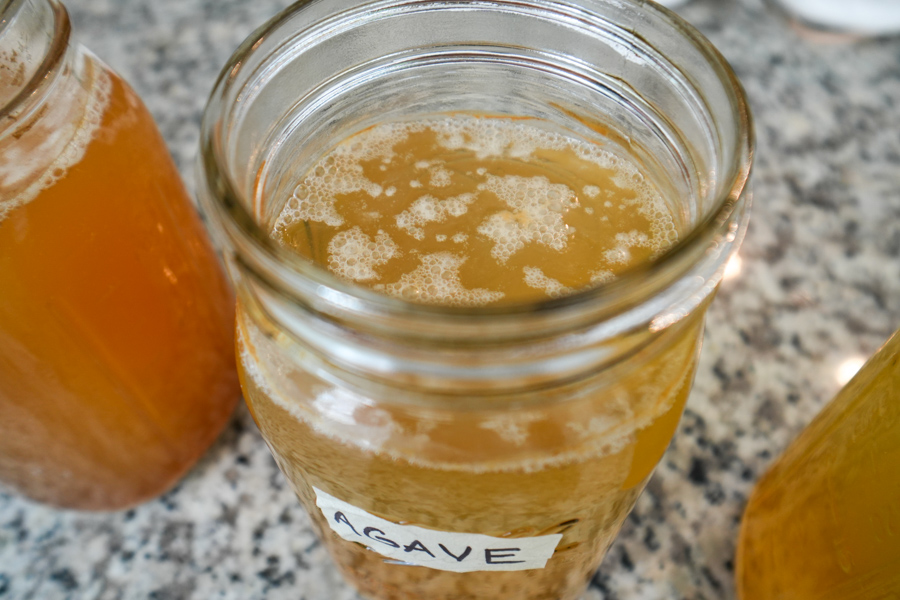
Honey
Can I use honey to make fermented sodas?
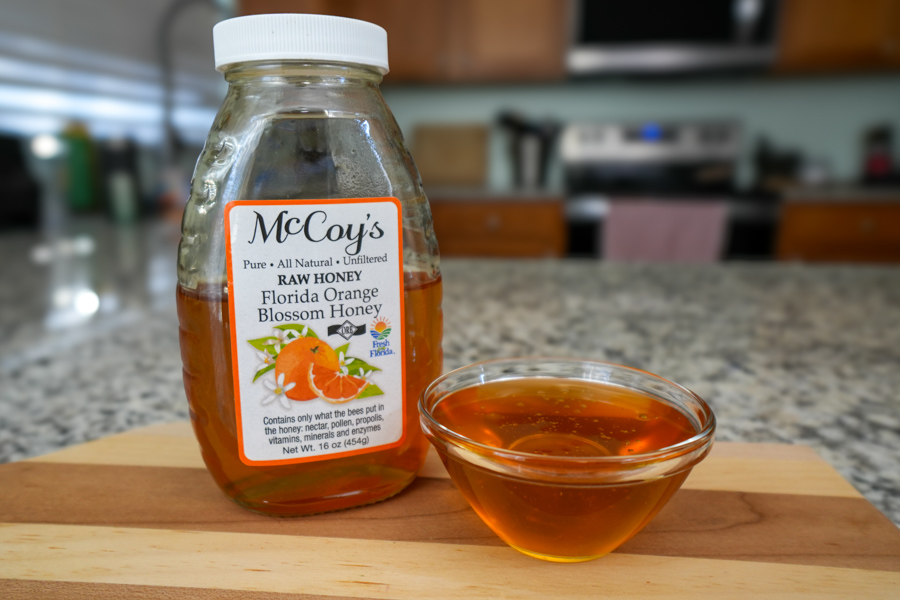
Honey is an unrefined sugar made from the effort of bees! It’s the oldest known sugar to have been used in the fermentation process and lasts a very long time due to its anti-microbial properties. It was even found in the Great Pyramids in Egypt, and it was still good after thousands of years! There are a wide variety of flavors of honey from orange blossom, wildflower, clover, palmetto, and many more. It’s extremely tasty when made into mead, or honey wine. Honey is fairly sweet, so we’d recommend using slightly less honey than raw sugar in your fermented soda recipe.
Amount: 1/2 cup minus 1 tablespoon (150 grams)
Verdict: Success!! 😍👑🔥💓🐝✨
This was the best tasting by far of all our fermented ginger ales and tasted similar to mead (honey wine). It ferments well, with a steady stream of beautiful champagne bubbles during the entire process, and it’s delicious with a crisp, clean flavor. Our new favorite sugar for making our fermented ginger ale!
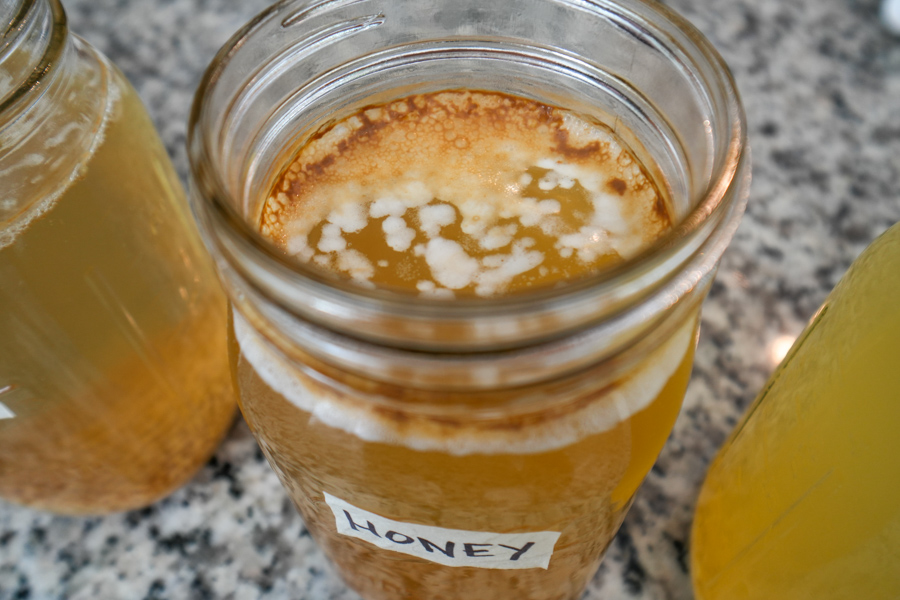
Fruit Puree
Can I make fermented sodas using just fruit?
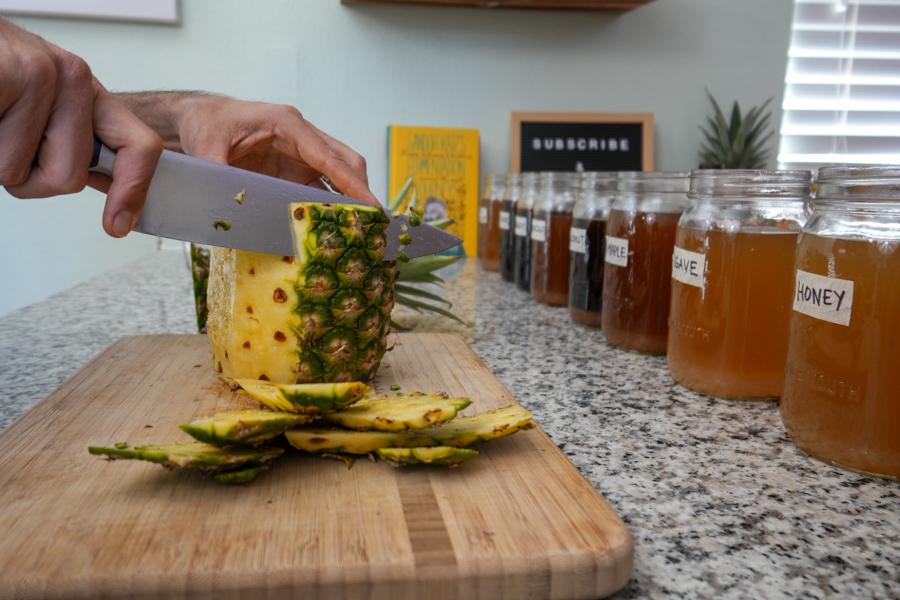
We’ve often been asked about using only fruit as a sugar source during fermentation, instead of using traditional sugars. So we thought we’ve test it out! We used one of the sweetest fruits we could think of – pineapple! If you try fermenting with fruit as your only source of sugar, just be aware that different fruit have different levels of sugar, and so the amounts of fruit needed for fermentation will vary. We also boiled the fruit puree to kill off any naturally occurring bacteria and yeast which could prevent our ginger bug from taking over as intended.
Amount: 2 cups of fruit (450 grams)
Verdict: Success. 😐🍍
Fruit ferments very quickly, so we’d recommend fermenting for less time than you usually would when using raw sugar. When left to ferment for the same amount of time as the raw sugar jar in this experiment, this fruit sweetened ginger ale was dry with just a hint of pineapple flavor. It was pleasant, like a light flavored probiotic drink.
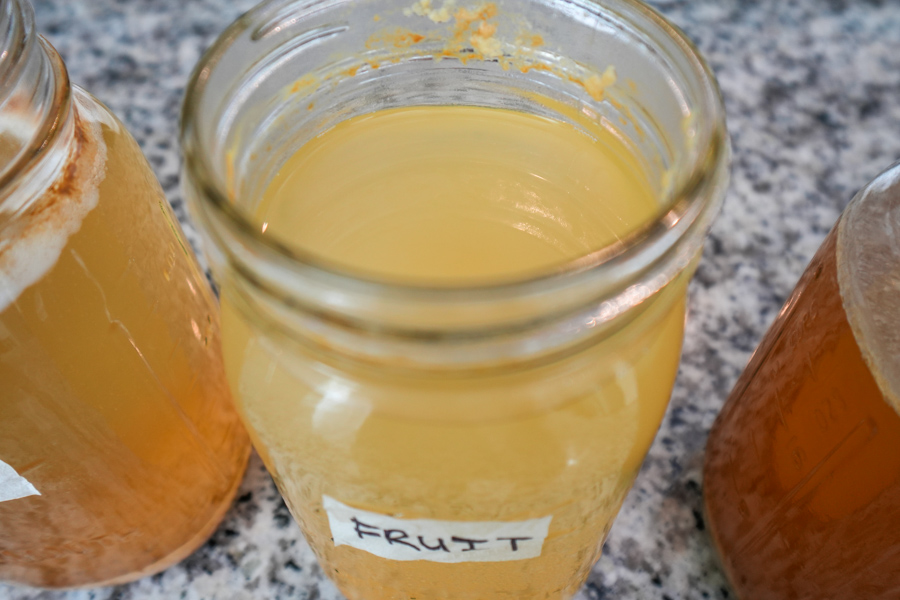
Stevia
Can I ferment with stevia?
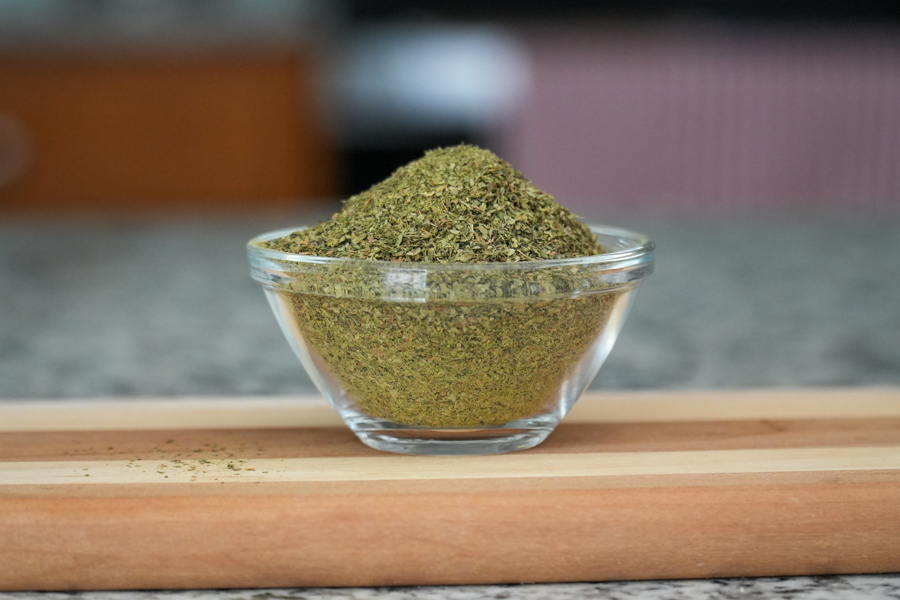
Stevia is an herb and a very popular zero-calorie sweetener that’s made from the stevia plant. We actually grew this ourselves, dried the leaves, and blended it up into a powder. It’s about three hundred times sweeter than sugar, so a little goes a long way! Even though it may taste sweet, we didn’t expect this to ferment since it doesn’t have any calories.
Amount: 1/2 teaspoon fresh powdered stevia
Verdict: Fail. 😝👎 Since there were no calories for the bacteria and yeast in our ginger bug starter culture to consume for energy, a mold layer started forming on the top. This would be expected of any zero-calorie sweetener.
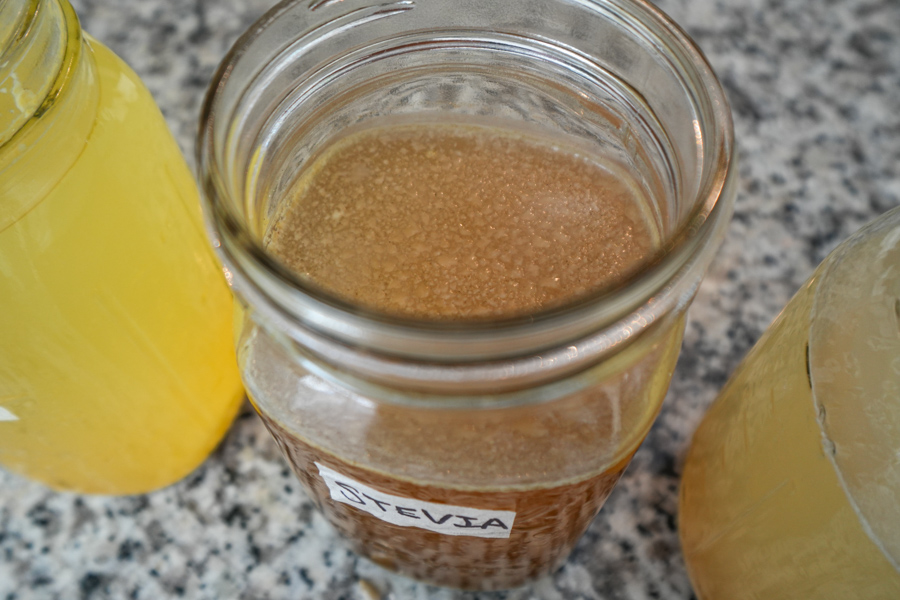
No Sugar
Can you ferment using no sugar at all?

Verdict: Fail. 😝👎
Since there are no calories for the bacteria and yeast in our ginger bug starter culture to consume for energy, we started to see mold. Again, this is to be expected.
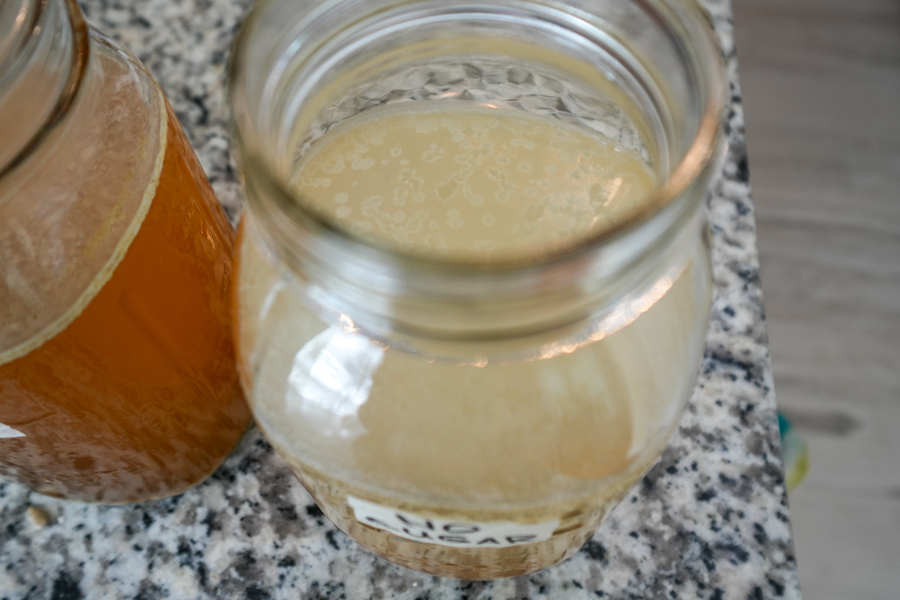
What’s your favorite sugar to use when making your homemade fermented sodas? Have you tried any other sugars? We’d love for you to leave a comment below and to subscribe to our YouTube channel!

